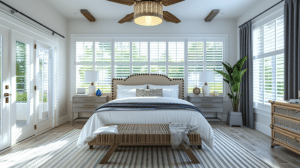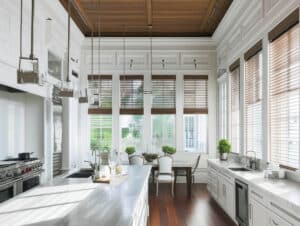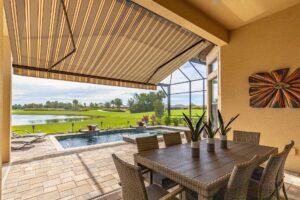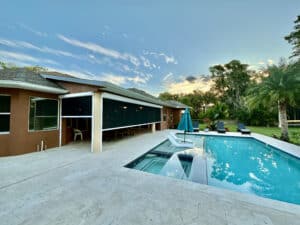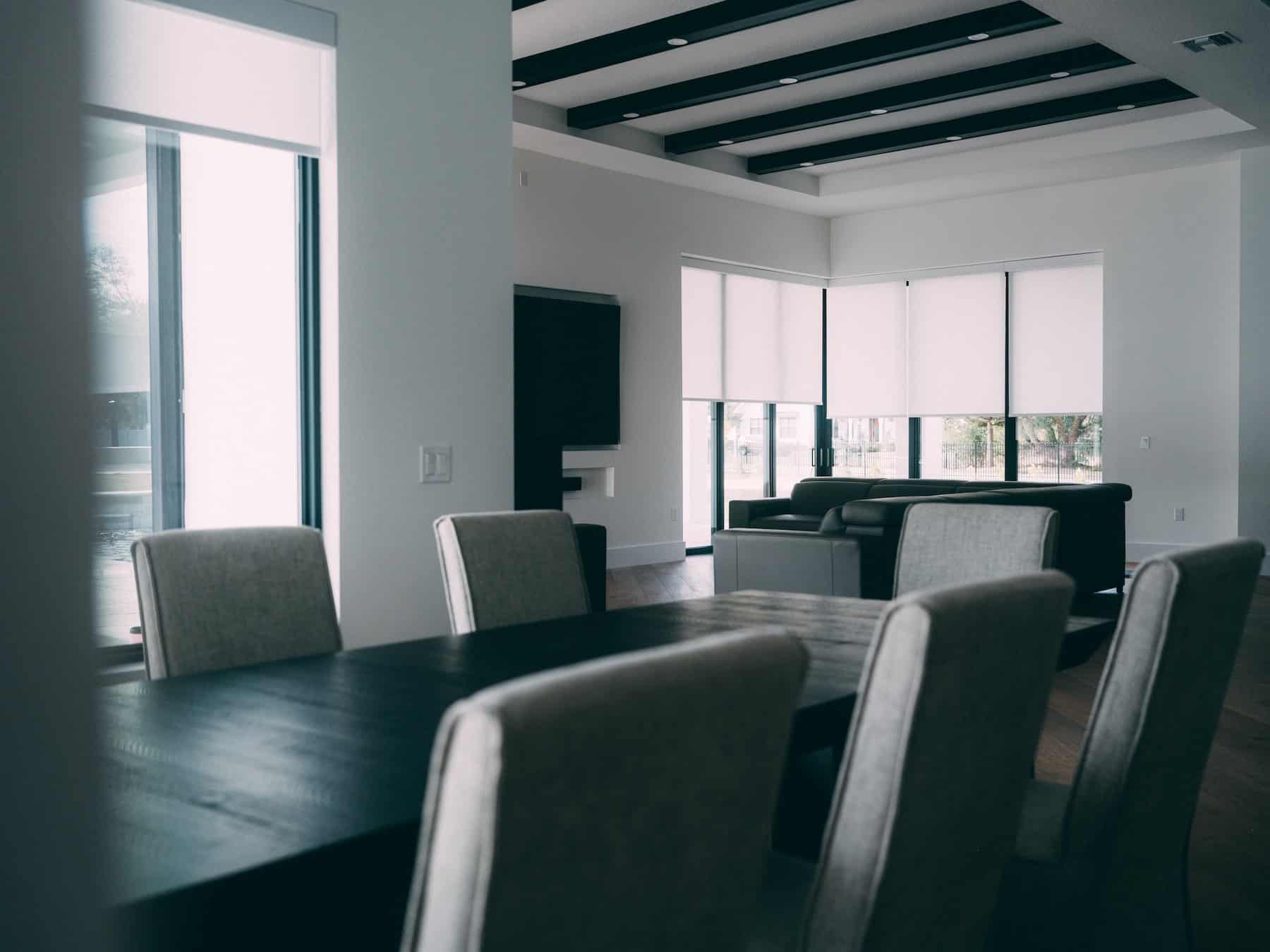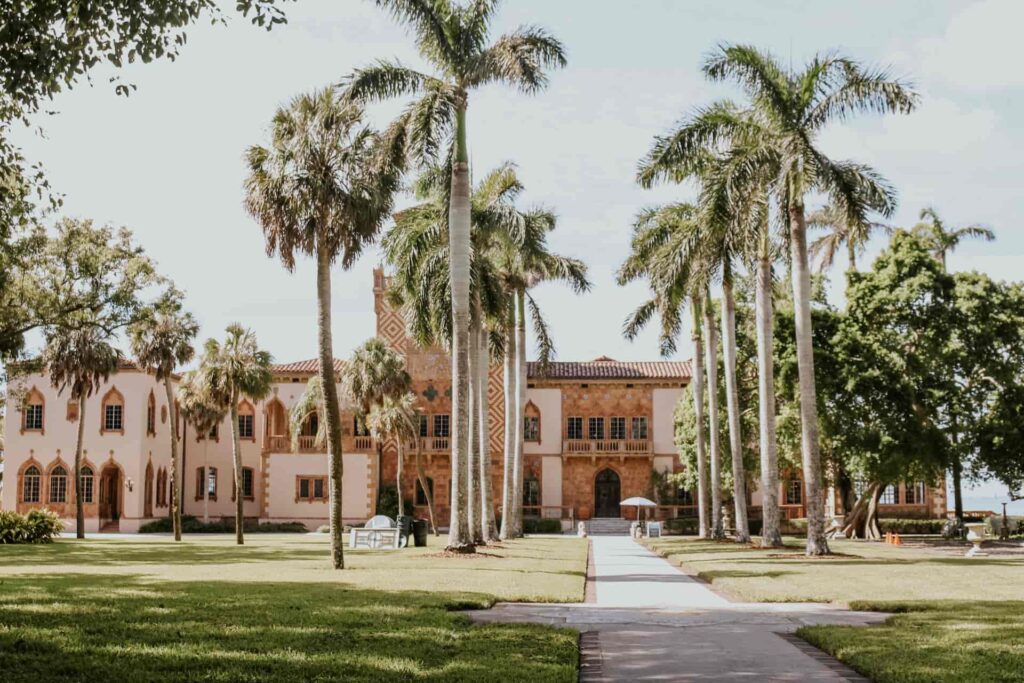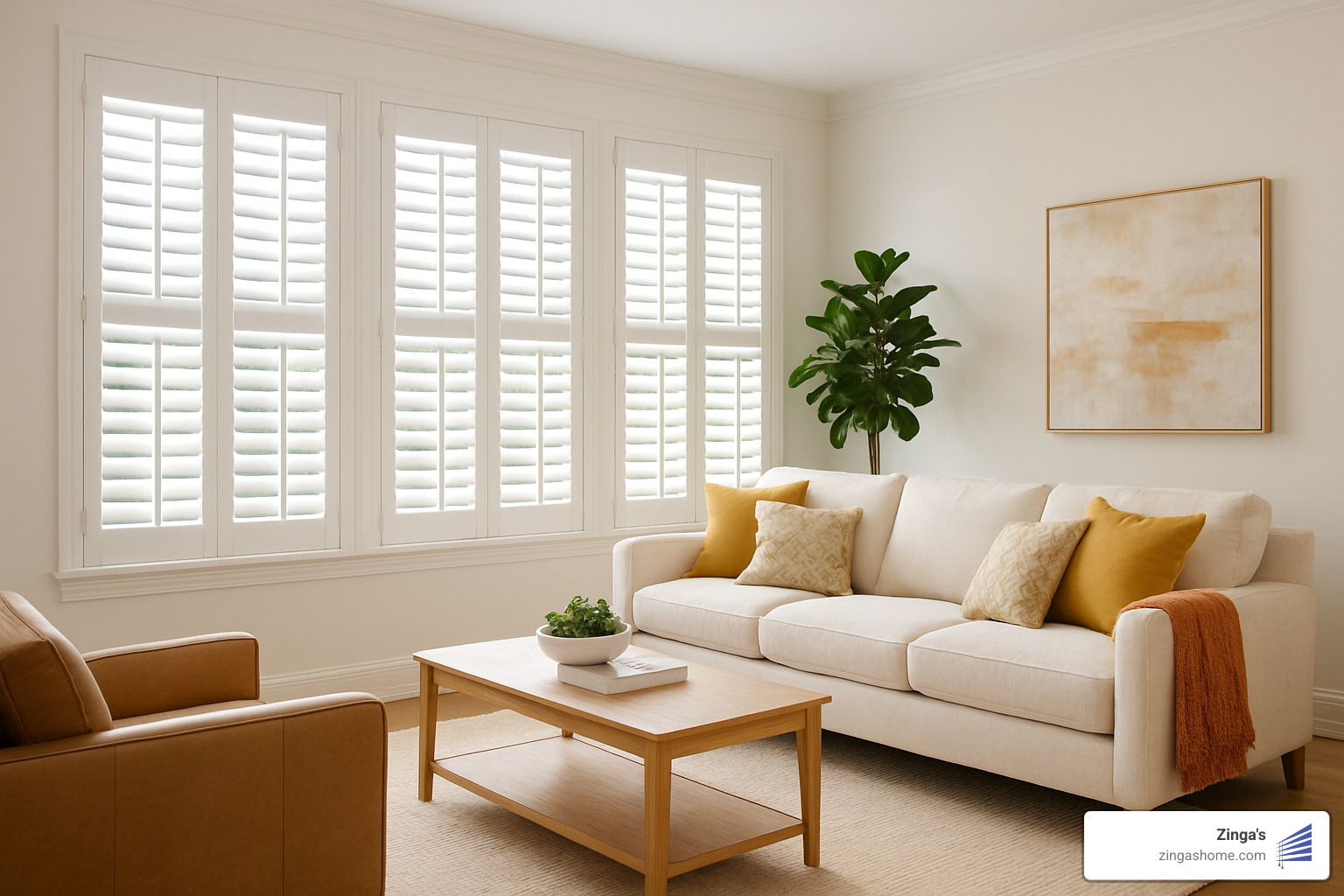
Your Essential Guide to Plantation Shutter Options
May 29, 2025
Buy 1 Get 1 50% OFF
Everything*
$750 OFF 1st Screen
$500 OFF 2nd Screen
Request Free
In-Home Consultation
Why Plantation Shutters Are the Ultimate Window Treatment Investment
Plantation shutter options have become one of the most sought-after window treatments for homeowners seeking style, function, and long-term value. These custom-fitted louvered panels offer superior light control, privacy, and energy efficiency compared to traditional blinds or shades.
Quick Plantation Shutter Overview:
- Materials: Wood, faux wood, vinyl, composite
- Styles: Full-height, café, tier-on-tier, bi-fold
- Cost Range: $70-$800 per window depending on material
- Lifespan: Up to 20 years with proper care
- Key Benefits: Energy savings, home value increase, timeless appeal
Unlike temporary window coverings, plantation shutters become permanent fixtures that can increase your home's resale value while providing decades of reliable performance. They excel in high-humidity areas like bathrooms and kitchens, offer superior insulation compared to blinds, and eliminate the safety concerns of dangling cords.
The challenge lies in choosing the right material, style, and mounting option for your specific needs and budget. Wood shutters provide classic warmth but require more maintenance, while composite and vinyl options offer durability at lower costs.
I'm George Huizinga, founder of Zinga's, and I've spent over a decade helping homeowners steer plantation shutter decisions through personalized consultations and expert installations. My experience has shown me that the right shutters transform not just windows, but entire living spaces.

Plantation shutter terms explained:
Understanding Plantation Shutters & Their Appeal
There's something timeless about plantation shutters that makes them feel both classic and completely current. Their story begins in Spain, where the wide-louvered design was first developed to handle intense Mediterranean sun. When Spanish colonists brought this clever window treatment to the American South, it quickly became a staple for good reason – those wide louvers could block scorching heat while still letting cooling breezes flow through.
What makes plantation shutters so appealing today goes far beyond their heritage design. Unlike the narrow slats you'll find on most blinds, plantation shutters feature wide louvers (typically 2½" to 3½") that give you much better control over light and privacy. Think of them as architectural elements rather than just window coverings – they become a fixed fixture that's part of your home's character.
Here's where shutters really shine compared to other window treatments: they're one of the few options that actually add resale value to your home. While blinds and shades are temporary additions, shutters are permanent improvements that appraisers recognize. They also work as natural insulators, creating an air pocket between the shutter and window that keeps your home more comfortable year-round. This energy efficiency can translate to real savings on your utility bills.
There's another benefit many homeowners don't expect – noise reduction. The solid construction of plantation shutters, especially real wood versions, helps absorb sound waves from outside. If you live near a busy street or just want a quieter, more peaceful home environment, shutters can make a noticeable difference.
What Makes a Plantation Shutter Unique?
The magic of plantation shutters lies in their louvered panels and how they're controlled. Each horizontal slat connects to a tilt rod system that lets you adjust all the louvers at once with a simple push or pull. It's this synchronized movement that gives you precise control over how much light enters your room and how much privacy you maintain.
Traditional shutters feature a front-mounted tilt bar that's easy to reach and operate. But if you prefer a cleaner, more modern look, many shutters now come with hidden tilt systems. These place the control mechanism on the back edge of the louvers, giving you an unobstructed view when the shutters are open while maintaining the same smooth operation.
Comparing Shutters, Blinds & Shades
When you're weighing your window treatment options, plantation shutters offer some distinct advantages. The biggest difference is how they heat block – shutters actually enclose the window frame, creating a sealed barrier that resists heat transfer much better than blinds hanging in front of the glass.
For light control, shutters give you more precision than most blinds, though they won't achieve the complete blackout levels you'd get from specialized room-darkening shades. If you need total darkness, shutters can be paired with blackout treatments behind them.
Safety is where shutters really stand out, especially for families. Their cordless operation eliminates the cord safety concerns that come with traditional blinds. No dangling cords means no strangulation risk for children or pets – something that's unfortunately a real concern with corded window treatments. Plus, the substantial construction of shutters provides better security and privacy protection than lightweight alternatives.
Types, Materials & Styles Explained
Choosing the right plantation shutter material is like picking the perfect foundation for your home's character. After helping hundreds of homeowners make this decision, I've learned that the best choice depends on your room's conditions, your style preferences, and how you plan to use the space.
Real wood shutters remain the gold standard for homeowners who want authentic beauty and craftsmanship. Typically made from basswood or poplar sourced from responsibly managed forests, these shutters bring natural grain patterns that add genuine warmth to any room. The rich texture and ability to stain or paint wood shutters in any color makes them incredibly versatile. However, they're also the investment option, ranging from $200 to $800 per window, and they need more care in moisture-heavy areas like bathrooms.
Faux wood shutters have become my go-to recommendation for most families because they deliver wood's visual appeal without the maintenance headaches. These composite shutters use engineered materials like MDF with realistic wood-grain finishes that fool most visitors. At $70 to $260 per window, they're significantly more budget-friendly than real wood. Plus, they're manufactured in about two weeks—half the time of custom wood shutters—which means you'll be enjoying your new window treatments much sooner.
Vinyl shutters shine brightest in challenging environments where moisture and easy cleaning matter most. Made from PVC or polysatin materials, these shutters can handle bathroom steam and kitchen grease without warping or staining. They're virtually maintenance-free and cost between $80 to $500 per pair. While they may not have wood's sophisticated appearance, they're perfect for utility areas and high-traffic spaces.
For those interested in cutting-edge options, specialty materials like Paulownia wood offer sustainability benefits, while advanced polymer composites provide exceptional durability for coastal homes dealing with salt air and humidity.
Pros & Cons by Material
Wood shutters create that authentic warmth that makes a house feel like home. The natural grain patterns are unique to each panel, and you can customize them with any stain or paint color to match your décor perfectly. But wood does require respect for its natural properties—it can warp in steamy bathrooms and needs occasional maintenance to prevent UV damage and moisture issues.
Faux wood shutters offer the sweet spot between beauty and practicality that most homeowners love. They resist peeling, cracking, and yellowing even when positioned in direct sunlight, and they won't warp in humid conditions. The main trade-off is that up-close inspection reveals they're engineered rather than natural wood, though today's manufacturing quality makes this difference minimal for most applications.
Vinyl shutters excel where durability and easy care matter most. You can literally clean them with bleach solutions without worry, and they'll never rot or warp no matter how much moisture they encounter. The compromise is a more utilitarian appearance that works better in casual spaces than formal rooms.
Composite shutters bridge the gap between wood and vinyl, offering improved strength and stability compared to solid wood while maintaining an authentic wood-like appearance. They handle temperature changes and humidity fluctuations better than natural wood, making them ideal for rooms with varying conditions.
Style Variations
The beauty of plantation shutters lies not just in their materials but in how different styles can transform your windows to match your lifestyle needs.
Full-height shutters cover your entire window opening and represent the classic choice that works beautifully in living rooms, bedrooms, and dining areas. They create clean, uniform lines that complement both traditional and contemporary architecture while providing complete light and privacy control.
Café style shutters offer a charming European approach by covering only the bottom half of your windows. This style gives you street-level privacy while keeping the top portion open for natural light—perfect for kitchens where you want privacy while cooking but don't want to feel closed in.
Tier-on-tier shutters feature separate top and bottom panels that operate independently, giving you the ultimate flexibility. You can close the bottom section for privacy while keeping the top open for light during the day, then adjust both sections for different evening needs. A divider rail positioned strategically on tall windows enables this split operation.
Bi-fold shutters solve the challenge of covering wider openings like French doors and sliding glass doors. They fold back completely to provide unobstructed access and create seamless flow between indoor and outdoor spaces—ideal for entertaining or everyday family life.
Bypass shutters slide horizontally on tracks, making them perfect for sliding glass doors where you don't have room for shutters to swing open. This style maintains the neat shutter aesthetic while working within space constraints that would make traditional hinged shutters impractical.
At Zinga's, we help you steer these choices during our in-home consultation, ensuring your plantation shutter selection perfectly matches both your practical needs and design vision.
How to Select the Perfect Plantation Shutter for Your Home
Choosing the perfect plantation shutters for your home doesn't have to feel overwhelming. At Zinga's, we've guided thousands of homeowners through this decision over the past decade, and we've learned that taking a thoughtful approach to each choice ensures you'll love your shutters for years to come.
The first major decision you'll face is whether to mount your shutters inside or outside the window frame. This choice affects both how your shutters look and how they perform. Inside mounts create that clean, built-in appearance that many homeowners love, but they do require enough depth in your window frame and might limit light on smaller windows. Outside mounts sit on your wall surface, giving you maximum light when the louvers are open and working beautifully when you have obstacles like window cranks or shallow frames.
Your louver size makes a bigger difference than most people realize. Traditional 2½" louvers give you that classic plantation look with more privacy when closed, while the modern 3½" louvers offer better views and more light when open. Larger louvers also mean fewer slats on tall windows, creating cleaner sight lines that many homeowners prefer.
When it comes to color and finish options, you're no longer limited to basic white. Custom stains can perfectly match your existing trim, while painted finishes open up unlimited possibilities to complement your décor. Many manufacturers now offer color-matching services, so you can coordinate with that perfect paint chip or fabric sample.
Safety should be a top priority, especially if you have children or pets. Cordless operation eliminates dangerous hanging cords, while hidden tilt rods remove protruding hardware that little hands might grab. For the ultimate in convenience and safety, motorized options let you control everything with a smartphone app or voice commands.
Don't forget about the practical details that make a big difference in daily use. Free samples help you see how materials and colors look in your actual lighting. Smart controls can automatically adjust your shutters based on time of day or temperature. Child and pet safety features give you peace of mind. And increasingly, eco-friendly materials let you make choices that are good for both your home and the environment.
When you're ready to explore your options, our Plantation Shutters collection showcases the full range of possibilities we can bring to your home.
Plantation Shutter Mounting: Inside vs Outside
Inside mount shutters create the most seamless, architectural look by fitting snugly within your window opening. This mounting style requires adequate depth clearance—typically 2 to 3 inches—and works best when you don't have protruding window cranks or deep trim getting in the way. The payoff is better insulation since the shutters seal your window opening more completely, and that coveted built-in appearance that looks like it was always part of your home's design.
Outside mount shutters attach directly to your wall surface around the window, making them your go-to solution for shallow openings or windows with obstructions. This mounting style has a practical advantage: more light enters when louvers are open, which is especially valuable for smaller windows where every ray of sunshine matters. Outside mounts can also go right over existing trim without requiring removal, preserving those decorative moldings you love.
The frame style you choose depends on your mounting type and affects both appearance and light control. Z-frames work beautifully for inside mounts in openings without existing trim, while L-frames adapt to various mounting scenarios. Frame width matters more than you might think—narrower frames maximize light when slats are open, while wider frames provide a more substantial look and better light blocking when closed.
Plantation Shutter Innovations & Upgrades
Today's plantation shutters incorporate technology that would have amazed homeowners just a decade ago. Motorized systems like PerfectTilt™ and PowerView® let you control your shutters with smartphone apps, voice commands, or even automatic programming based on time of day or sun position. These systems optimize energy efficiency by adjusting throughout the day without you having to think about it.
Hidden tilt rod systems eliminate visible hardware for those clean, modern aesthetics while keeping operation simple and smooth. Some manufacturers offer split-tilt capabilities with divider rails, letting you control upper and lower louver sections independently on tall windows—perfect for privacy below while maintaining light above.
Advanced construction features include recessed magnets instead of exposed hardware for streamlined appearance, and polypropylene coatings borrowed from medical and automotive applications that dramatically improve durability. These innovations mean your shutters will look better and last longer than ever before.
Smart home integration represents the cutting edge of shutter technology. Your shutters can now work with whole-house automation systems, contributing to energy management and security protocols. Latest research on smart-home energy savings shows that automated window treatments can reduce energy costs by 10-15% through optimized solar heat gain control—savings that add up significantly over time.
Installation, Budget & ROI
When it comes to plantation shutter installation, you'll face a choice that can make or break your investment: DIY or professional installation. Having guided countless homeowners through this decision at Zinga's, I've seen how the right choice transforms both the process and the results.
The allure of DIY installation is understandable—many manufacturers offer detailed guides and supposedly "easy" pre-hung systems. However, plantation shutters are among the most challenging window treatments to install correctly. Unlike hanging curtains or mounting basic blinds, shutters must fit with precision to function properly. Even small measurement errors can result in gaps that let in unwanted light, binding that prevents smooth operation, or poor alignment that compromises the entire look.
Professional installation, on the other hand, brings peace of mind that extends far beyond convenience. When you invest in custom shutters, you want them to improve your home for decades to come. Professional installers handle the complexities that can trip up even experienced DIYers—out-of-square windows, unusual shapes, and integration with existing trim.
The financial picture involves more than just the initial purchase price. Custom plantation shutters typically range from $145 to $347 per window, with material choice driving most of the cost variation. Wood shutters command premium pricing at $200 to $800 per pair, while Faux Wood Shutters offer excellent value at $70 to $260 per window, and vinyl options fall between $80 to $500 per pair.
What makes plantation shutters a smart investment is their return on investment potential. Unlike temporary window treatments that depreciate immediately, quality shutters often add to your home's appraisal value. The energy savings from improved insulation help offset costs over time, and many homeowners qualify for energy efficiency tax credits when installing qualifying window treatments. Manufacturing typically takes 2-4 weeks, with professional installation usually completed in one day per room.
Measuring & Ordering Steps
Getting accurate measurements is absolutely critical for plantation shutter success, and it's trickier than most homeowners realize. While professional measuring services eliminate guesswork entirely, careful DIY measuring is possible if you understand the key principles.
The most important rule is measuring window opening height at three points—left side, middle, and right side—then using the smallest measurement to guarantee proper clearance. Older homes often have settling that creates out-of-square openings, so width measurements should also be taken at multiple points. Don't forget depth measurements, which determine your mounting options and frame styles. Inside mounts need specific minimum clearances for smooth operation.
Most manufacturers provide comprehensive measuring guides and templates, with phone support available for complex situations. Taking advantage of free samples lets you evaluate materials and colors before committing to full orders. If you're working with standard sizes, some companies offer "quick ship" programs that can reduce lead times to just 1-2 weeks instead of the typical month.
Professional Installation Advantages
Professional installation delivers advantages that extend far beyond saving you time and effort. Experienced installers bring specialized tools and expertise to handle complex situations that can stump even handy homeowners—windows with unusual shapes, intricate trim work, and structural modifications.
The time savings alone make professional installation worthwhile for many homeowners. While DIY shutter installation can stretch over weeks of weekends, professional installation of whole-house shutters typically takes just 1-2 days. Plus, professionals carry insurance coverage and offer warranties on both materials and workmanship, protecting your investment.
Perhaps most importantly, professional installers provide quality control throughout the process. They can identify and correct issues during installation, while DIY mistakes often aren't apparent until the project is complete—and by then, fixes can be costly and time-consuming. Most professional installations include follow-up service to address any operational adjustments needed after your home settles.
At Zinga's, our bias for action means we're proactive about solving installation challenges before they become problems. Our experienced team brings over a decade of expertise to ensure your Plantation Shutters not only look beautiful but function flawlessly for years to come.
Care, Maintenance & Lifespan
The beauty of plantation shutters lies not just in their timeless appeal, but in their remarkable durability when properly maintained. With the right care routine, quality shutters can grace your windows for up to 20 years, making them one of the smartest long-term investments in your home's comfort and value.
At Zinga's, we've seen countless shutters that still look stunning after decades of use, and the secret isn't complicated—it's consistency. Your shutters work hard every day, adjusting to filter light, provide privacy, and insulate your home. A little regular attention keeps them functioning smoothly and looking their best.
The maintenance routine varies slightly depending on your shutter material, but the basics remain the same across all types. Weekly dusting with a vacuum brush attachment removes the everyday accumulation of dust and debris that can build up between louvers. For deeper cleaning, a damp wipe with a microfiber cloth handles fingerprints and surface soil that naturally occur with regular use.
Most homeowners find that hinge lubrication once or twice a year keeps operation smooth and prevents the squeaking that can develop over time. A few drops of appropriate lubricant on moving parts goes a long way toward maintaining that satisfying, solid feel when you adjust your shutters.
Environmental factors play a big role in shutter longevity. UV protection from window films or treatments helps prevent fading and material degradation, while maintaining consistent indoor humidity levels protects against warping and expansion issues. These simple steps, combined with shutters made from sustainable sourcing practices, create a window treatment that truly stands the test of time.
Cleaning by Material
Timber care requires the gentlest approach to preserve the natural beauty and finish of real wood shutters. Start with your vacuum's brush attachment to remove loose dust, then follow with a soft cloth or specialized shutter brush designed to fit between louvers. The key with wood is avoiding excess moisture—use only a barely damp cloth for spot cleaning, and always dry immediately to prevent water damage.
When your wood shutters need a little extra care, a high-quality wood polish applied sparingly can restore luster and provide protective coating. Think of it as moisturizing your shutters—a little goes a long way, and over-application can actually attract more dust.
Faux wood cleaning offers much more flexibility, which is why composite shutters have become so popular in busy households. These engineered materials can handle more aggressive cleaning methods, including prepared cleaning solutions for stubborn spots. You can use a wet cloth without worry, and even mild detergent solutions when needed for deeper cleaning.
Vinyl shutters are practically bleach-safe in most cases, making them the ultimate low-maintenance option. They can handle everything from gentle soap and water to stronger cleaning solutions for removing mildew or tough stains. Some homeowners even hose down their vinyl shutters during spring cleaning—just be sure to test any cleaning product on a hidden area first to check for potential discoloration.
Extending Shutter Life
Creating an inspection schedule doesn't have to be formal or complicated—simply make it a habit to notice how your shutters operate during regular use. Are the louvers staying aligned? Do the hinges move smoothly? Is the tilt rod responding properly? Catching small issues early prevents them from becoming expensive problems later.
Louver realignment is often a simple fix that homeowners can handle themselves. If you notice a slat that's not staying in position with the others, it may just need a small adjustment to the staples or clips that hold it in place. This kind of minor maintenance can add years to your shutters' life.
The hinges on your shutters work constantly, especially on frequently used windows. Regular inspection ensures they stay properly aligned and operate smoothly. If you notice any binding or unusual resistance, a small amount of appropriate lubricant usually solves the problem. Quality hinges typically last many years, but in high-use areas, they may eventually need replacement—a much less expensive option than replacing entire shutters.
Environmental protection remains one of the most important factors in extending shutter life. Protecting your shutters from direct moisture exposure, maintaining reasonable indoor humidity levels, and using UV protection creates conditions where quality shutters often outlast multiple generations of other window treatments.
For homeowners interested in learning more about maintaining their investment, How do I maintain and clean plantation shutters? provides additional tips and community insights from other shutter owners who've finded their own maintenance shortcuts and solutions.
Frequently Asked Questions about Plantation Shutters
When it comes to plantation shutters, homeowners often have similar questions about performance, value, and versatility. After helping thousands of customers through our expert consultations at Zinga's, I've found these three questions come up most frequently.
How do plantation shutters improve energy efficiency?
Plantation shutters work like a thermal blanket for your windows, creating an insulating air pocket between the glass and your living space. This barrier is far more effective than traditional blinds or shades because of the shutters' solid construction and tight-fitting installation.
During hot summer months, closed shutters block solar heat from entering while the adjustable louvers still allow some airflow for comfort. In winter, that same air space acts like a buffer zone, preventing your heated indoor air from escaping through the windows—typically the weakest point in your home's insulation.
What makes shutters particularly effective is their ability to eliminate air leaks. Unlike fabric shades or thin blinds that can flutter or gap, quality shutters seal tightly against the window frame. Research shows this can reduce your energy costs by 10-15%, which means the shutters often pay for themselves over time through lower utility bills.
Do plantation shutters add value to my home?
This is one of my favorite questions because the answer is a resounding yes! Plantation shutters are among the few window treatments that actually increase your home's appraised value. Unlike removable blinds or curtains, shutters become permanent architectural features that buyers view as premium upgrades.
Real estate professionals consistently tell us that homes with quality shutters sell faster and often command higher prices. The combination of timeless style, energy efficiency, and durability appeals to buyers who recognize shutters as a long-term investment rather than a decorative accessory.
Most homeowners recover 50-80% of their shutter investment in increased home value. When you factor in the energy savings and 20-year lifespan, plantation shutters frequently provide better returns than other home improvements. At Zinga's, we've seen this through our customers who later move and tell us their shutters were a major selling point.
Can plantation shutters be installed on French or sliding glass doors?
Absolutely! Plantation shutters are actually perfect for French doors and sliding glass doors—you just need the right configuration. We install bi-fold shutters specifically designed for wider openings that fold back completely when you want to use the doors.
For French doors, shutters can either swing with the doors themselves or mount as stationary panels that fold to the sides. The bi-fold design lets the shutters stack neatly out of the way, so you keep that beautiful indoor-outdoor flow that makes French doors so appealing.
Sliding glass doors work beautifully with bypass shutters that slide horizontally on tracks, just like the doors themselves. This setup gives you all the privacy, insulation, and style benefits of Plantation Shutters without sacrificing the space-saving advantages of sliding doors.
We've successfully installed shutters on countless door applications across our service areas, and the results always impress homeowners. The key is working with experienced professionals who understand the specific hardware and measurements needed for these larger openings.
Conclusion
When you step back and look at all the benefits, plantation shutters truly stand out as one of the smartest investments you can make in your home. They're not just window coverings—they become part of your home's character, offering timeless appeal that works beautifully whether your style is traditional farmhouse or sleek modern.
The energy savings alone make a compelling case. With utility bills constantly rising, having shutters that can reduce your heating and cooling costs by 10-15% means they practically pay for themselves over time. Add in the increased home value and the fact that quality shutters can last up to 20 years, and the math becomes pretty clear.
What I love most about helping families choose the right plantation shutters is seeing how they transform not just the look of a room, but how it feels. There's something special about the way shutters filter light—creating that warm, welcoming glow that makes a house feel like home. Whether you choose the rich warmth of real wood or the practical beauty of composite materials, you're investing in daily comfort and long-term value.
At Zinga's, we've learned that the best shutter decisions come from understanding your unique situation. Do you have young children who need cord-free safety? Are you dealing with a humid bathroom that demands moisture-resistant materials? Is curb appeal your top priority, or are you focused on noise reduction for better sleep? These details matter, and they guide us toward the perfect solution for your family.
Our in-home consultations take the guesswork out of the process entirely. We bring samples directly to your home so you can see how different materials and colors look in your actual lighting. We measure precisely, discuss your lifestyle needs, and explain all your options in plain English. No pressure, no surprises—just honest guidance from people who genuinely care about getting it right.
The installation process is surprisingly smooth when you work with experienced professionals. Most homes can be completed in a day or two, and the change is immediate. One day you're dealing with old blinds that never quite work right, and the next you're enjoying the smooth operation and beautiful appearance of custom plantation shutters that will serve your family for decades.
Ready to see what plantation shutters can do for your home? We'd love to show you the possibilities with a complimentary consultation. There's no obligation—just an opportunity to explore how the right window treatments can improve your daily life and protect your investment in your home.
More info about Dallas plantation shutter services and find how our comprehensive approach can transform your living spaces from the inside out.

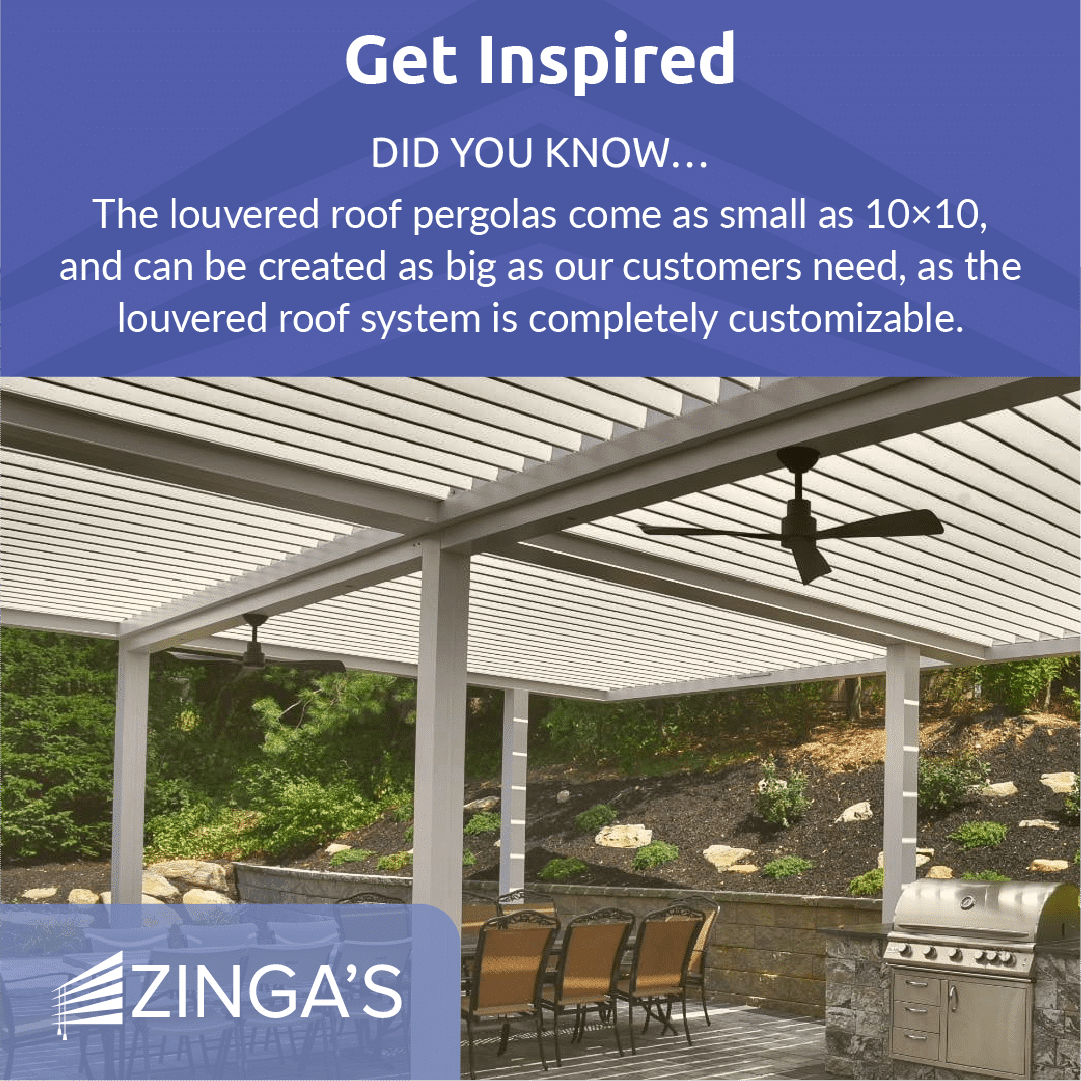
Recent Posts
Motorized Shades vs Manual Shades: Which Is Worth the Extra Cost?
Wood vs Composite Shutters in Humid Climates: Which Holds Up Better?
Why Your Motorized Blinds Stutter or Stall: Troubleshooting 5 Common Failures
Categories
Download our Motorized Pergola Guide
Looking for inspiration? Download our free feature packed pdf and see what all options you can get in your pergola.
Table of Contents
- Why Plantation Shutters Are The Ultimate Window Treatment Investment
- Understanding Plantation Shutters & Their Appeal
- What Makes A Plantation Shutter Unique?
- Comparing Shutters, Blinds & Shades
- Types, Materials & Styles Explained
- Pros & Cons By Material
- Style Variations
- How To Select The Perfect Plantation Shutter For Your Home
- Plantation Shutter Mounting: Inside Vs Outside
- Plantation Shutter Innovations & Upgrades
- Installation, Budget & Roi
- Measuring & Ordering Steps
- Professional Installation Advantages
- Care, Maintenance & Lifespan
- Cleaning By Material
- Extending Shutter Life
- Frequently Asked Questions About Plantation Shutters
- How Do Plantation Shutters Improve Energy Efficiency?
- Do Plantation Shutters Add Value To My Home?
- Can Plantation Shutters Be Installed On French Or Sliding Glass Doors?
- Conclusion
What Products Are You Interested In?
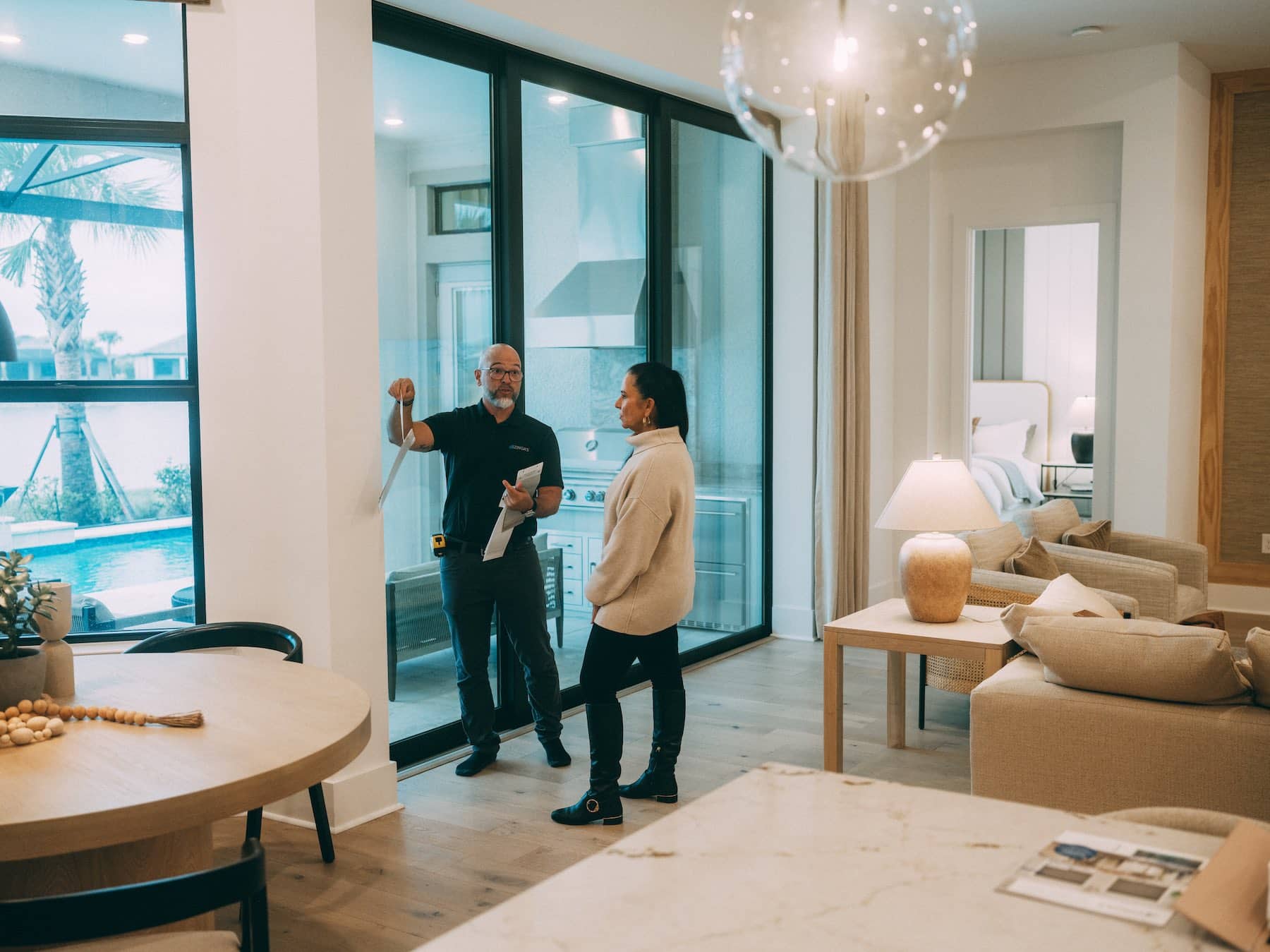
Shades Made Simple.
STEP 1: Complimentary In-Home Consultation
We bring sample products & fabrics directly to your home so you can see and feel the products in your home.
STEP 2: Precise Measuring & No Pressure Quote
We take precise measurements of all your windows and provide you a no pressure quote at the time of your consultation.
STEP 3: Hassle Free Installation
Installation completed by Zinga's employee who are experts in their craft. Free yourself of the stress of installing.
Building a Home?
Building a home can be stressful enough, let us take the burden of window treatments off your hands. We will meet with you after your drywall is complete and can install as soon as you move in!







Who Is Zinga’s?
Zinga’s has been offering window treatments for 25 years and has grown 25% year over year! How did we do that? Simple, we’ve put our customer first. We genuinely love our customers and giving them great service. We want to wow our customers and when you wow your customers they give great referrals. See our over 2000+ reviews, our customers speak for themselves!
Learn More About Zinga's







